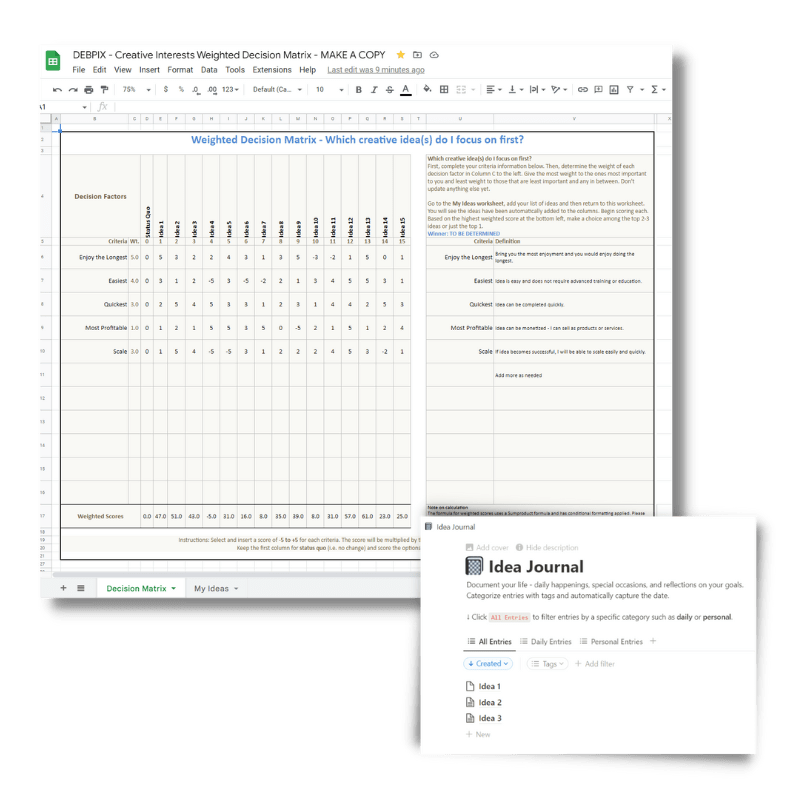As creative people who tend to dabble in various creative interests and constantly come up with a slew of creative ideas, we find it’s almost impossible to focus solely on one. Because of this, our lives are often filled with half-completed projects and we feel like we’re never making any progress.
Working as an employee of someone else’s company or even our own company, we’re always expected to be able to juggle and multitask, so why would we think we couldn’t pull this same approach off in our personal lives and with our creative interests?
For decades the multitasking expectation has been imposed on anyone working in corporate America yet there are studies showing that only 2.5% of us can multitask effectively. Multitasking is not a good strategy. Juggling is not a good strategy. Bouncing from idea to idea and half-completing all of them is keeping most of us stuck and not hitting the goals that we want to hit. In our personal endeavors, we must strive to focus on one creative idea at a time.
But that doesn’t mean we lose sight of all of our other ideas.
So how do you choose one creative idea to focus on when so many are rolling around in your head? Read on and find out.
Table of Contents
Strategy 1: The Low-Tech Approach
- Grab a piece of paper and list all of your ideas. For this example, let’s say you have 15.
- Create two columns.
- In the first column, rank the ideas according to which you would enjoy doing the longest. Your number 1 choice should be the one you would enjoy doing the longest. If you have 15 on your list, you should ultimately have one ranked at 1 and another at 15, with the rest in between.
- In the second column, rank the ideas according to which will be the easiest or quickest to implement and/or complete. In this ranking, 1 is the easiest and quickest and 15 is the most difficult and takes the longest.
- Where do they overlap? The top 1, 2 or 3 are where you need to start. This is your creative niche.
- Don’t discard the rest of your ideas. Instead, keep them in a notebook or journal and call it your “Idea Journal.” Keep the journal handy on an ongoing basis.
- Give each remaining idea its own page so that any new related ideas can easily be added. When you have new unrelated ideas, create new pages for them as well.
- Occasionally grab the journal. Set yourself a timer for about 15 minutes. Think of all of the ideas racing through your head and add them to your journal. Do this with some frequency or whenever ideas hit you. This practice will get the ideas out of your head and in a safe spot and will free up your mind to focus on the ones you already decided you were going to tackle first (see step 5 above).
Strategy 2: The Quasi-Hi-Tech Approach
- For those of you who are paper averse or simply prefer to do exercises electronically, grab my free Google Sheets-based Creative Ideas Decision Matrix below.
- Within the worksheet you will be able to:
- Record your ideas in a list
- List your criteria. Some examples are already provided to get you started, such as:
- Enjoy the Longest – would bring the most joy and for the longest
- Easiest – doesn’t require advanced training or education
- Quickest – can be completed and/or launched quickly
- Profitable – the ability to monetize
- Scale – the ability to scale quickly and easily with growth in sales, for example
- Give weight to each criterion (some are more important than others)
- Score each idea for each criterion
- Determine your top 1-3 ideas to start with based on the resulting highest weighted score(s). This is your creative niche.
- Don’t discard the rest of your ideas. Instead, keep them in a notetaking app like Keep or Notion and call your note or journal “Idea Journal.” Keeping either journal handy is easily accomplished through their mobile app and/or desktop version.
- Give each remaining idea its own page or note so that any new related ideas can easily be added. When you have new unrelated ideas, create new pages or notes for them as well.
- Occasionally access the journal. Set yourself a timer for about 15 minutes. Think of all of the ideas racing through your head and add them to your journal. Do this with some frequency or whenever ideas hit you. This practice will get the ideas out of your head and in a safe spot and will free up your mind to focus on the ones you already decided you were going to tackle first (see step 2 above).

Conclusion
Regardless of the approach you choose, what the above steps ensure is that you will remain focused on what’s most important to you while simultaneously not losing track of all of the other ideas that pop into your head on a regular basis. The above steps will free you from the “too many ideas syndrome.”
But we’re not done.
Set yourself a goal based on time, achievement, and/or milestones relating to the idea(s) you decided you would focus on. Once you hit the goal, give yourself permission to start on the next most important idea in your Idea Journal.
What might happen for you is that you will gain vision and clarity around what you are already doing. You might find the additional interests or ideas would be a distraction and are no longer important to you. Those ideas are still there, though, and can be picked up at any time should you ever have the inclination to pursue them.


